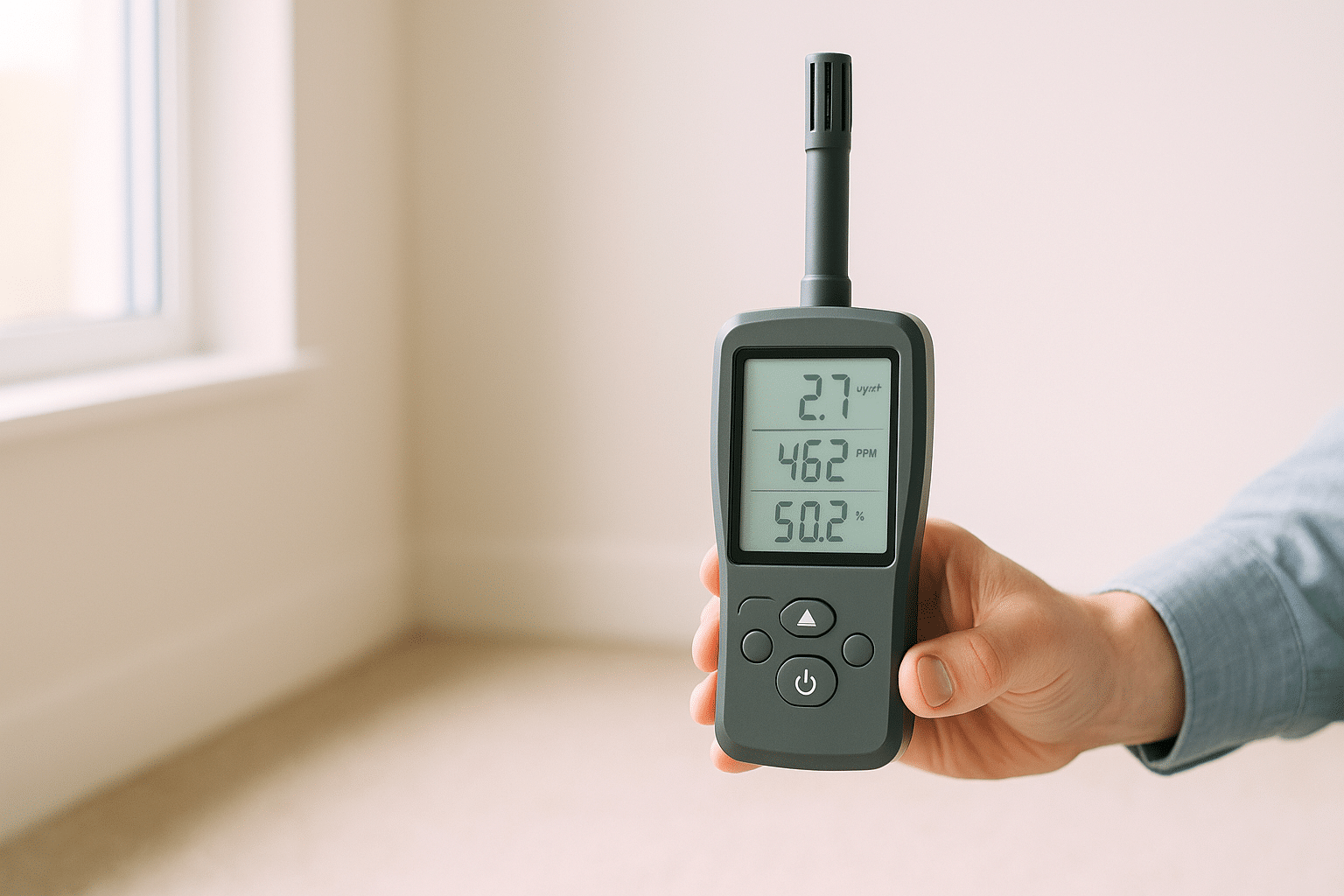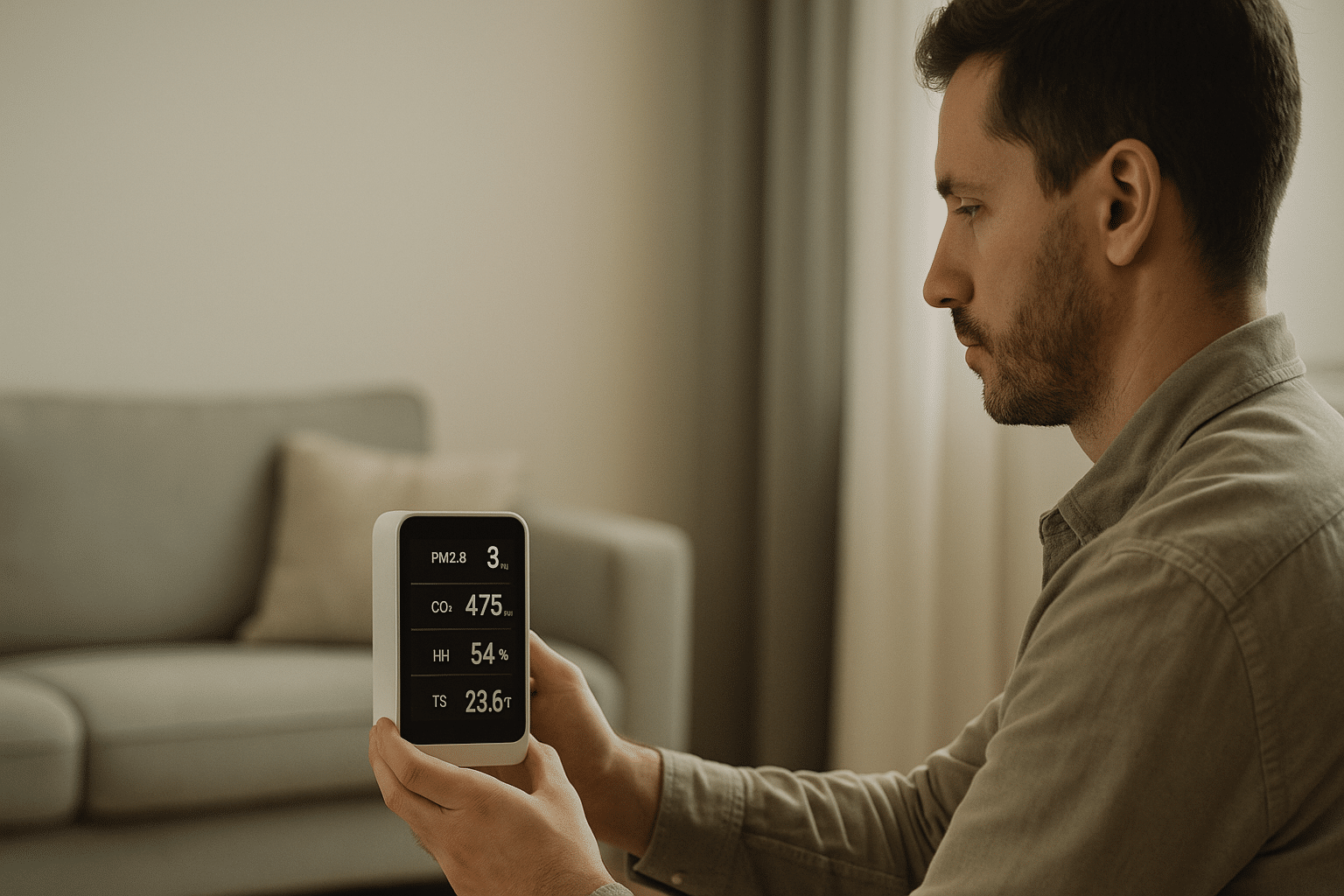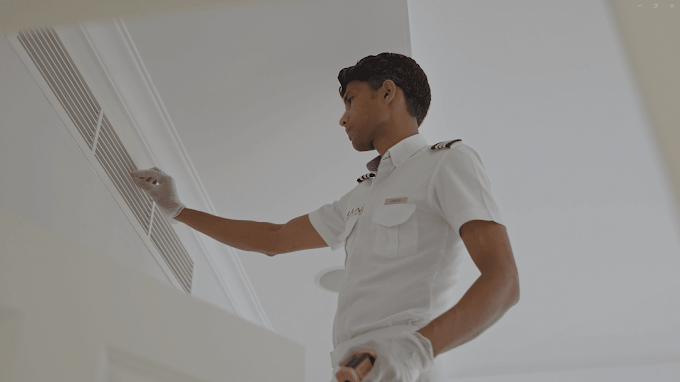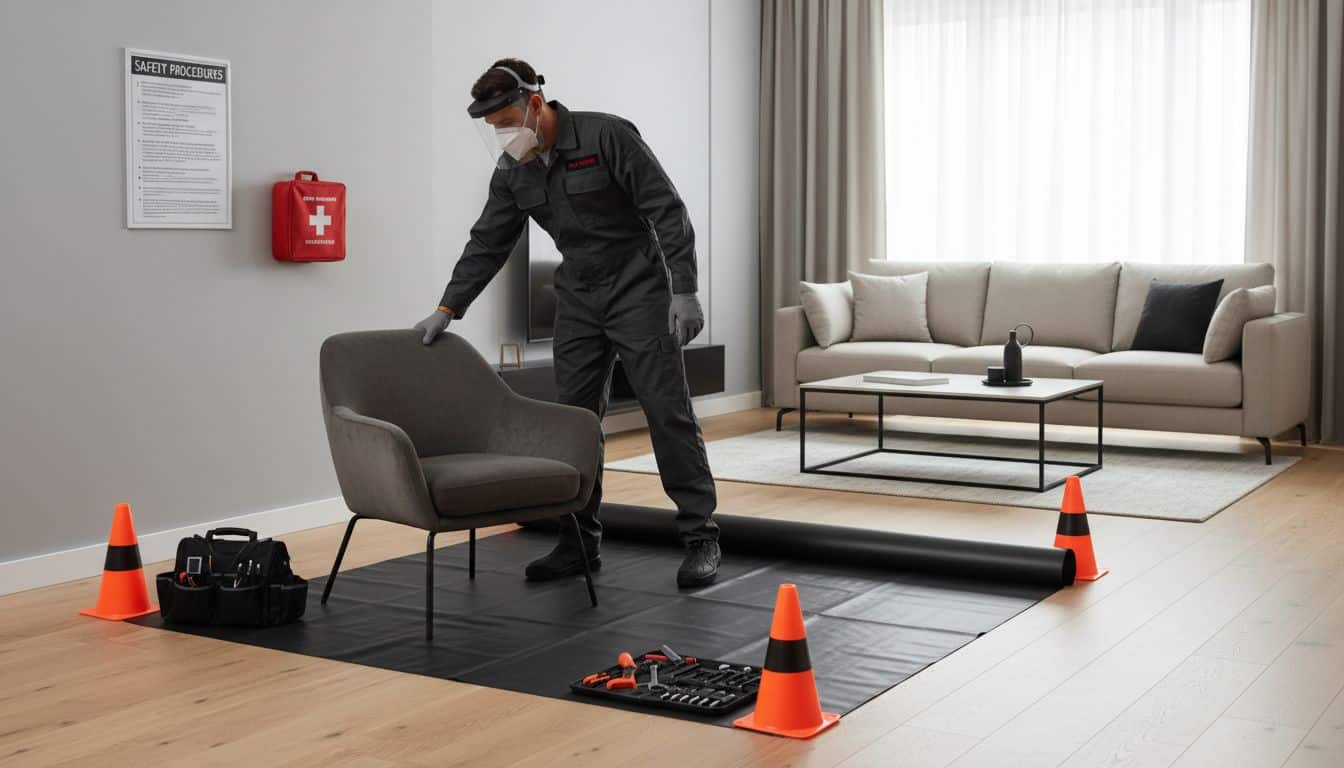
10 Key Insights into the Indoor Air Quality Testing Process for Effective AC and Duct Maintenance in Dubai
Table of Contents
Contents
- 1 Table of Contents
- 2 Introduction to the Indoor Air Quality Testing Process
- 3 Importance of Indoor Air Quality Testing in Dubai
- 4 Dubai Guidelines and Standards for Air Quality
- 5 Essential Maintenance Steps for AC and Ducts
- 6 Common Indoor Air Quality Testing Methods
- 7 Tools and Equipment Used in the Testing Process
- 8 How to Interpret Indoor Air Quality Test Results
- 9 Actionable Improvements After Testing
- 10 Choosing Professional Indoor Air Quality Testing Services in Dubai
- 11 Conclusion and Call to Action
- 12 Understanding the Indoor Air Quality Testing Process
Introduction to the Indoor Air Quality Testing Process
The indoor air quality testing process plays a critical role in maintaining a healthy and comfortable environment inside homes and workplaces in Dubai. With increasing urbanization and gas emissions, ensuring clean indoor air quality is more important than ever before. This article explores the indoor air quality testing process, focusing on effective service and maintenance steps for air conditioning (AC) and ducts, tailored specifically to Dubai’s climate and regulations.
Importance of Indoor Air Quality Testing in Dubai
Dubai’s unique desert climate, combined with high population density and industrial activity, means indoor air can harbor pollutants that affect wellbeing. The indoor air quality testing process helps identify contaminants such as dust, mold spores, volatile organic compounds (VOCs), and particulate matter (PM), which can directly impact respiratory health and overall comfort.
Health-conscious residents and businesses in areas like Downtown Dubai, Business Bay, and Dubai Marina increasingly demand routine testing to ensure their indoor environment meets safety standards. Proper air quality protects against allergies, asthma, and other respiratory ailments common in urban settings.
Dubai Guidelines and Standards for Air Quality
Dubai Municipality, along with Dubai Health Authority (DHA) and Emirates Authority for Standardization & Metrology (ESMA), oversees indoor air quality standards. These authorities require commercial and residential buildings to adhere to specific ventilation and air cleanliness guidelines, which the indoor air quality testing process must address.
Compliance with these standards helps property owners avoid fines and contributes to healthier living spaces amidst Dubai’s hot and dusty environment.
Essential Maintenance Steps for AC and Ducts
Maintaining AC units and ducts is indispensably linked to the indoor air quality testing process. Dust accumulation and microbial growth in ducts often degrade air quality. Here are key maintenance actions:
- Regular cleaning of AC filters: Replace or clean filters every 1-3 months to prevent dust and allergens circulation.
- Duct inspection and cleaning: Schedule thorough cleaning to remove dust, mold, and debris, especially in older buildings in districts like Nad Al Sheba or Arabian Ranches.
- Check for leaks: Seal any duct leaks to prevent outdoor pollutants from entering indoor air streams.
- System tuning: Ensure proper airflow and refrigerant levels for efficient performance and better air quality.
Following these maintenance steps optimizes the indoor air quality testing process outcome and supports long-term indoor health.
Common Indoor Air Quality Testing Methods
The indoor air quality testing process incorporates several methods, focusing on detecting multiple contaminants. These include:
- Particulate Matter Sampling: Measures PM2.5 and PM10 levels, crucial in Dubai due to frequent dust storms.
- Volatile Organic Compounds (VOCs) Detection: Identifies harmful chemical emissions from paints, adhesives, or cleaning agents.
- Microbial Sampling: Detects mold spores and bacteria, vital for preventing respiratory infections.
- Carbon Dioxide and Carbon Monoxide Monitoring: Assesses ventilation efficiency and indoor combustion pollutants.
- Humidity and Temperature Measurement: Controls environmental parameters affecting indoor air quality.
Professional testing services often blend these methods for comprehensive analysis.
Tools and Equipment Used in the Testing Process
Reliable tools are crucial for an accurate indoor air quality testing process. Common equipment used in Dubai includes:
| Tool | Description |
|---|---|
| Particle Counters | Measures airborne particles and dust concentration levels. |
| Gas Detectors | Detects gases like CO, CO2, and VOCs. |
| Humidity and Temperature Sensors | Monitors conditions affecting mold growth. |
| Microbial Air Samplers | Captures airborne bacteria and mold spores. |
| Surface Sampling Kits | Tests dust and microbial contamination inside ducts and vents. |
Technicians in Dubai trained under Dubai Municipality ensure these tools are correctly used for valid readings during the indoor air quality testing process.
How to Interpret Indoor Air Quality Test Results
Once tests complete, understanding results is essential to take corrective steps. Key indicators to look for include:
- Particulate Levels: Values above recommended limits indicate dust or pollutant ingress, suggesting filter or duct issues.
- VOC Concentration: High VOCs usually point to chemical sources indoors requiring ventilation improvement.
- Microbial Counts: Elevated mold spores demand duct cleaning and humidity control.
- CO and CO2 Levels: Excessive carbon monoxide signals dangerous leaks; high carbon dioxide highlights poor ventilation.
- Humidity Readings: High relative humidity supports microbial growth; below 30% may cause dryness and irritation.
Consulting with Dubai-certified indoor air quality professionals can help translate these results into actionable maintenance plans.
Actionable Improvements After Testing
The indoor air quality testing process findings guide targeted interventions. Improvements may include:
- Upgrading to high-efficiency particulate air (HEPA) filters suitable for Dubai’s dusty environment.
- Increasing fresh air ventilation rates per Dubai Municipality’s safety standards.
- Scheduling regular professional duct cleanings to remove contaminants.
- Using air purifiers equipped with activated carbon filters to reduce VOCs and odors.
- Installing humidity control devices to maintain optimal moisture levels.
Timely maintenance and upgrades ensure the indoor air quality testing process remains a vital part of healthy building management in Dubai.
Choosing Professional Indoor Air Quality Testing Services in Dubai
When selecting a trusted service provider for the indoor air quality testing process in Dubai, consider experience, certification, and localized expertise. Companies like Saniacservice specialize in Dubai’s climatic needs, delivering comprehensive testing and maintenance solutions.
Additionally, membership in associations such as the National Air Duct Cleaners Association (NADCA) ensures adherence to international best practices adapted for Dubai’s market.
Professional services not only perform precise testing but also advise on maintenance and upgrades that align with Dubai Municipality guidelines.
Conclusion and Call to Action
The indoor air quality testing process is an indispensable step toward safeguarding indoor environments in Dubai. With a proactive approach to AC and duct maintenance, residents and businesses can enjoy cleaner, healthier air. Supporting Dubai’s regulations, this process protects health, enhances comfort, and boosts HVAC system performance.
Contact trusted Dubai-based experts today to schedule your professional indoor air quality testing process and implement effective maintenance measures. Breathe cleaner air and experience the benefits of a well-maintained indoor environment.
Understanding the Indoor Air Quality Testing Process
Ensuring healthy indoor environments has become a priority across Dubai, especially in the wake of heightened awareness about air pollution and its effects on human health. The indoor air quality testing process is a methodical approach to evaluating the air you breathe inside homes, offices, schools, and commercial buildings throughout Dubai’s urban landscape, from Business Bay high-rises to residential areas like Arabian Ranches. For a more in-depth understanding, you can understand the indoor air quality testing process better.
Indoor air can contain a range of pollutants, including dust, volatile organic compounds (VOCs), mold spores, carbon monoxide, and other harmful gases. These contaminants often come from building materials, ventilation systems, cleaning agents, or outdoor air leakage. The indoor air quality testing process identifies these pollutants, helping property owners and facility managers comply with Dubai Municipality regulations and the Dubai Health Authority’s environmental health guidelines.
Initial Assessment and Planning
The testing process begins with an initial assessment carried out by certified indoor air quality (IAQ) specialists. In Dubai, professionals trained under regulations set by Dubai Municipality and DHA conduct on-site evaluations to understand the building’s unique characteristics. This stage includes:
- Reviewing the building’s layout, age, ventilation systems, and occupancy patterns.
- Identifying potential sources of indoor pollutants specific to the location, such as proximity to construction sites in Downtown Dubai or heavy traffic zones near Dubai Marina.
- Checking existing ventilation and filtration equipment for adequacy and maintenance status as per Dubai Health & Safety standards.
The specialists will also discuss any health complaints reported by occupants, since symptoms like headaches, respiratory irritation, or fatigue can indicate poor indoor air quality. This initial consultation shapes the testing strategy by targeting specific pollutants of concern and selecting suitable sampling locations within the building.
Sampling and Data Collection
Once the assessment is complete, the actual indoor air quality sampling takes place. This stage involves carefully collecting air and surface samples to identify contaminants quantitatively and qualitatively. In Dubai, the process typically involves the following:
- Air Sampling: Using portable air quality monitors and detectors compliant with Dubai Municipality standards, samples are taken from various rooms, ventilation ducts, and occupant breathing zones. Equipment such as photoionization detectors (PIDs), particle counters, and gas analyzers measure levels of pollutants like VOCs, particulate matter (PM2.5 and PM10), carbon dioxide, carbon monoxide, and formaldehyde.
- Surface and Dust Sampling: In certain cases, swabs and dust collection are performed to detect mold spores, allergens, and bacterial contamination. This is essential for buildings with previous moisture problems or visible mold growth, common in humid coastal areas like Nad Al Sheba.
- Environmental Parameters Monitoring: Factors affecting air quality, such as temperature, relative humidity, and airflow rates, are monitored. These influence pollutant levels and occupant comfort and are vital metrics per Dubai Health Authority guidelines.
Collection times and methods follow protocols recommended by Dubai Municipality’s environmental control unit and adhere to procedures outlined by the Dubai Health & Safety Code. The data gathered is then sent to accredited laboratories within Dubai, where detailed chemical and biological analysis is performed.
Analysis and Reporting
The air and surface samples undergo rigorous testing at Dubai-based laboratories accredited by DHA and ESMA (Emirates Authority for Standardization and Metrology). These labs use advanced analytical methods to measure pollutant concentrations and identify harmful agents. The analysis results are compared against local and GCC indoor air quality standards and thresholds, which are increasingly being harmonized with international best practices but tailored for Dubai’s climate and infrastructure context.
Upon completing the analysis, a comprehensive report is prepared, which includes:
- Summary of pollutants detected and their concentrations.
- Interpretation of data versus Dubai Municipality air quality limits.
- Identification of potential sources behind elevated contaminant levels.
- Recommendations for corrective actions to improve air quality, including ventilation upgrades, filtration system enhancements, moisture control, or behavioral changes.
This reporting phase is integral for building management, facility operators, and residents as it informs necessary steps toward healthful indoor air environments. The findings also help ensure compliance with Dubai’s work environment and residential health laws, reducing risks of sick building syndrome and enhancing overall well-being.
Follow-Up and Remediation
After the delivery of the test report, the next phase is implementing suggested improvements. In Dubai, remediation might include upgrading HVAC systems to meet Dubai Electricity and Water Authority (DEWA) efficiency criteria or conducting regular duct cleaning in accordance with Dubai Municipality’s environmental maintenance regulations.
Facility managers are encouraged to carry out routine monitoring and, if necessary, re-testing to verify that intervention measures have effectively improved air quality. Ongoing maintenance plays a critical role, especially in highly populated or commercial areas like Dubai Media City or the Dubai International Financial Centre, where indoor air pollutant loads can quickly accumulate.
Dubai-based IAQ service providers often offer continuous air quality monitoring solutions that integrate with building automation systems. These allow real-time tracking of air pollution parameters and automated alerts when thresholds are exceeded, ensuring prompt action to safeguard occupants’ health.
Key Benefits of Following a Structured Indoor Air Quality Testing Process
- Health Protection: Identifying allergens, toxins, and irritants before they affect occupants’ health.
- Regulatory Compliance: Supporting adherence to Dubai Municipality and Dubai Health Authority environmental standards.
- Energy Efficiency: Optimizing ventilation systems to balance air quality with energy conservation.
- Occupant Comfort: Creating pleasant indoor environments conducive to productivity and relaxation.
- Property Value: Maintaining good IAQ helps preserve building integrity and market appeal in Dubai’s competitive real estate sector.
In summary, the indoor air quality testing process in Dubai is a comprehensive, regulated approach that blends scientific analysis with practical solutions tailored to regional environmental conditions and regulatory frameworks. Engaging with certified local professionals ensures that indoor spaces meet health standards and provide clean, breathable air for all occupants.






Leave a Reply